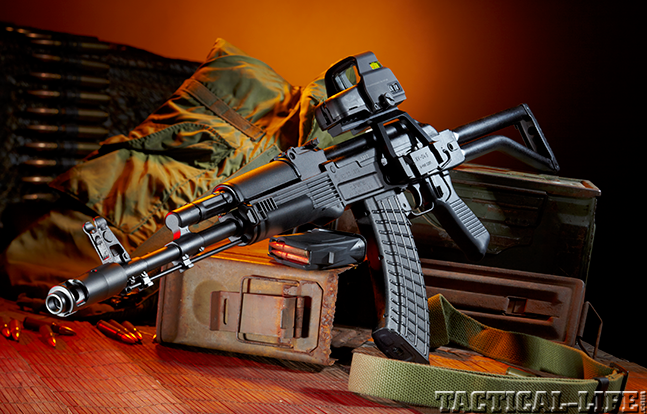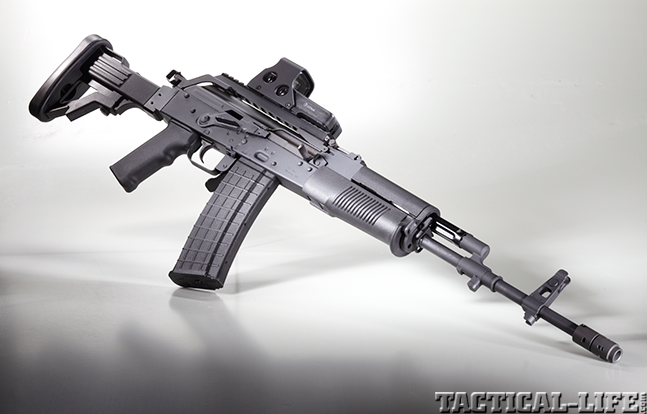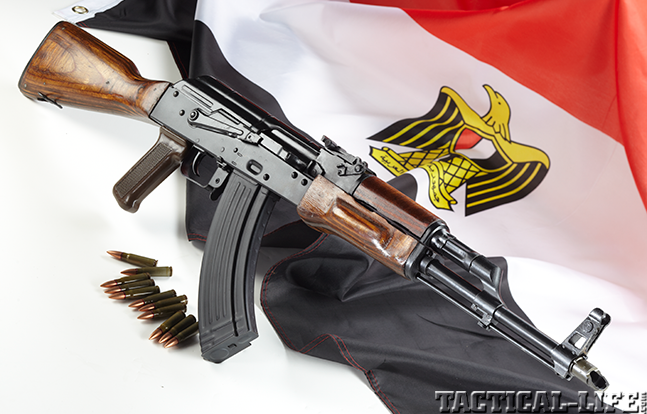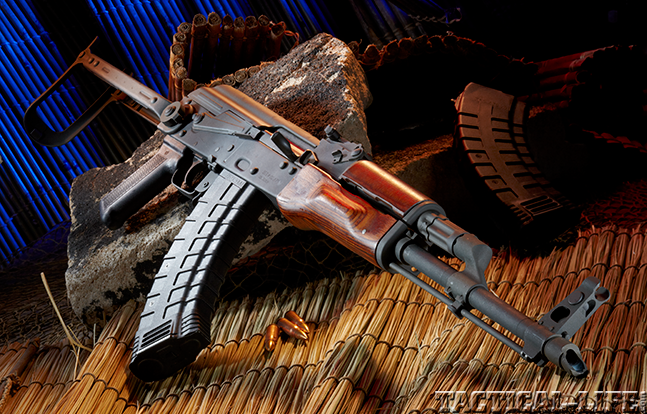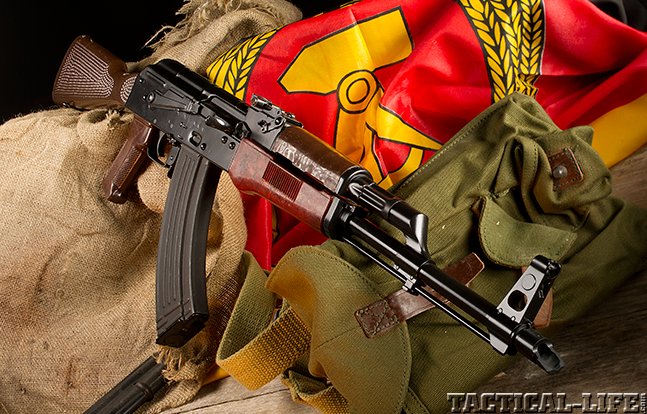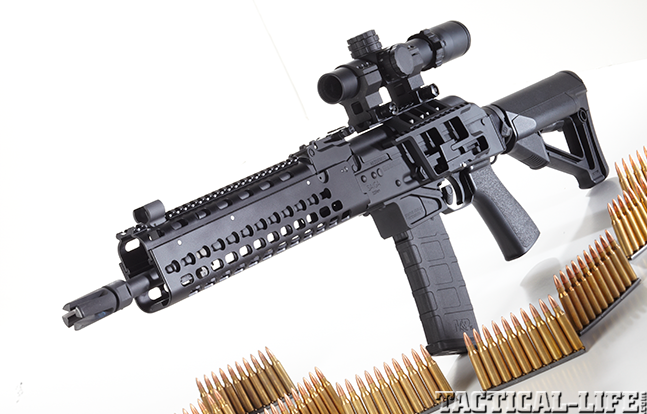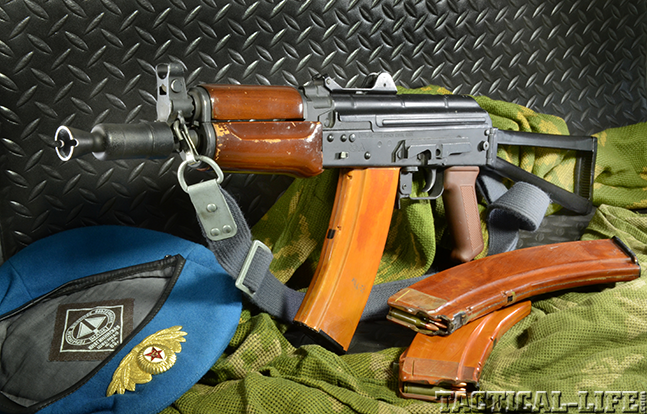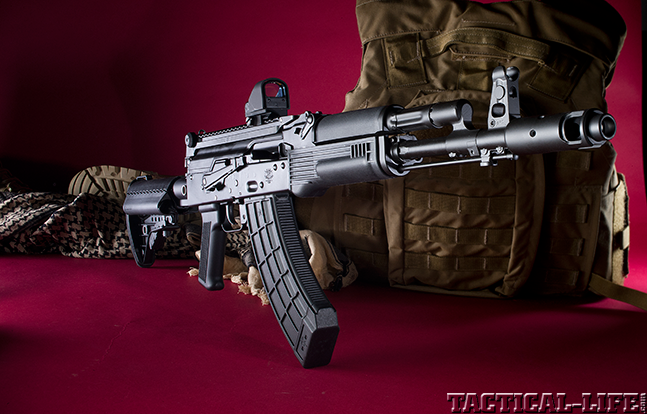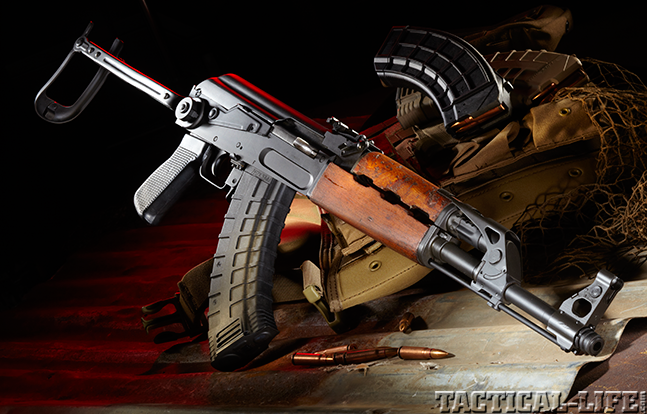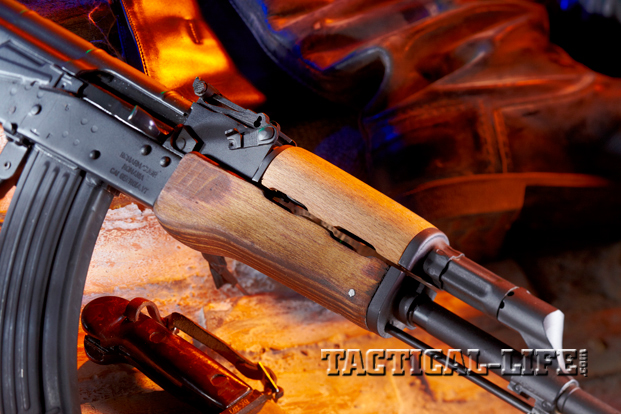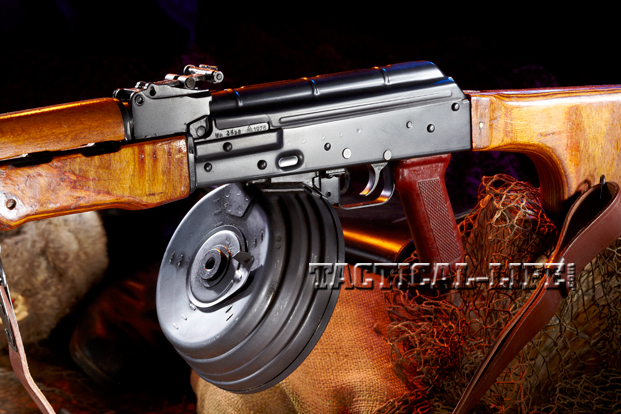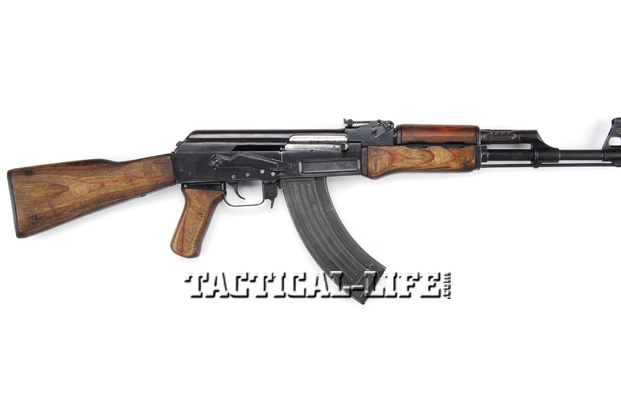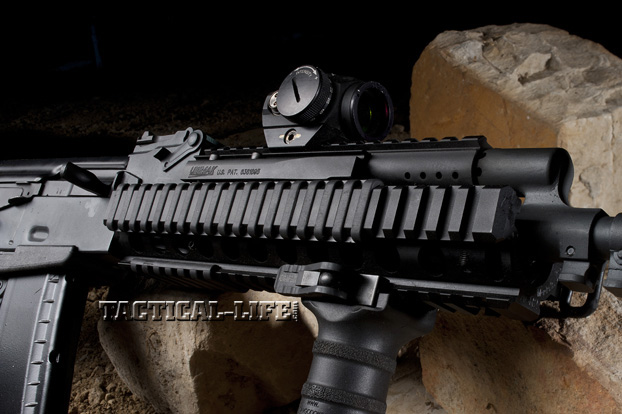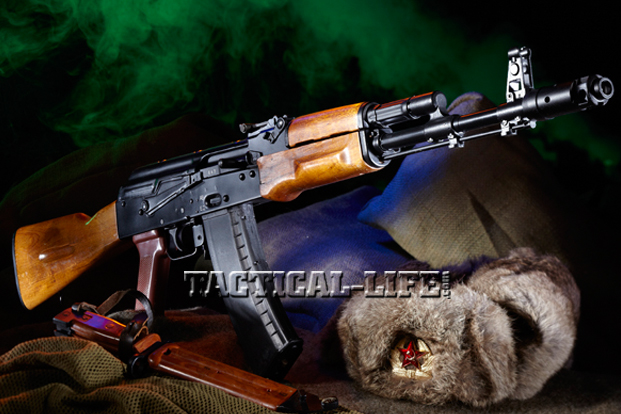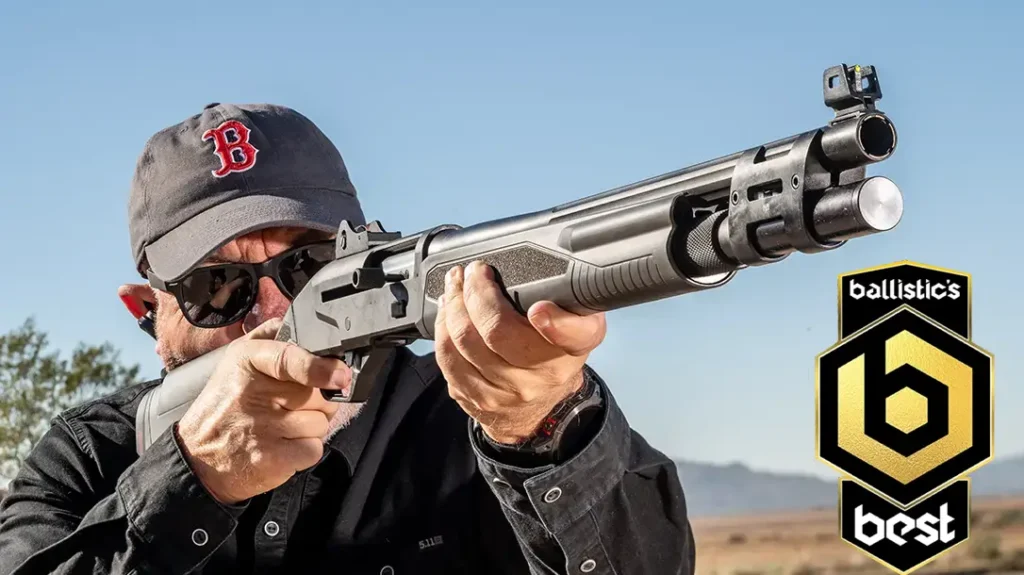The Avtomat Kalashnikova (better known to the world as the AK-47), the brainchild of Mikhail Kalashnikov, has the distinction of being the most prolifically produced firearm on the face of the planet. Why is this? Because the classic Russian design represents a near-perfect balance of affordability, reliability, simplicity, and durability. While criticized by many for its supposed “crudeness,” AK rifles ironically represent its own approach to engineering refinement — namely the beauty of form following function.
Here in the United States in its semi-automatic form, the AK and its derivatives have proven to be extremely popular with American shooters. However, the availability of Russian-made AK rifles here in the United States has recently been altered. Executive Order 1366, Ukraine-Related Sanctions, has restricted Concern Kalashnikov’s line of products from importation. Unless reversed, this action prevents any future importation of the company’s products. As a result, the demand for and value of Russian-made, semi-automatic Kalashnikov variants has increased dramatically here on the domestic market.
Tactical Life’s Top 20 AK Rifles & Soviet Weapons
1. I.O. Inc. 5.56 Archer
Advertisement — Continue Reading Below
Of the Archer, author Michael O. Humphries writes, “With Poland’s close ties to the West, it would seem appropriate that U.S. consumers might have a chance to own their own version of this impressive rifle. And, thanks to the efforts of I.O. Inc., we do. The company’s Archer rifle is a civilian-legal, semi-automatic rendition of the classic Beryl rifle imported and adapted for sale here in the United States.
“The rifle is imported in a single-stack magazine configuration by I.O. Inc. and then modified with the requisite amount of U.S.-made parts to allow it to legally accept double-column magazines. As offered, the Archer is configured similarly to the latest versions of the Beryl rifle, with a collapsible synthetic stock and a rock-solid optical rail mount located above the rifle’s top cover. The Archer comes standard with a U.S.-made polymer magazine from ProMag, a component that’s required to be used with the rifle as part of its 922r compliance.”
For more information, please visit IOinc.us.
Advertisement — Continue Reading Below
2. Arsenal SAM7SF
Of the SAM7SF, author Jeff Zimba writes, “Arsenal places its primary emphasis on quality over quantity, and it has been its business model to produce the highest quality AK rifles at the expense of pumping them out as fast as they can all along. Quality can’t be combined with cutting corners to increase productivity. so as they have been filling orders on existing models as fast as they can, they have also continued to work on new designs in a parallel manner. It is this dedication that brings us to their latest offering, the SAM7SF.”
For more information, please visit ArsenalInc.com.
Advertisement — Continue Reading Below
3. Piece of History Firearms Egyptian Misr 7.62x39mm
Of the Egyptian Misr, author Michael O. Humphries writes, “… the Misr closely followed the standard Russian AKM pattern. The stock set was in the AKM pattern, made from laminated wood, and featured palm swells on the sides of the lower handguard. The rifle’s top cover was of thin sheet steel with reinforcing ribs for added strength, and the gas block was in the traditional 45-degree angle pattern. The finish of the rifles was a black paint applied over the metal parts. In fact, with just a quick glance at the rifle, it would be quite hard for many to easily distinguish it from a Russian-made rifle.
“What really sets the Misr apart from a more traditional AKM are samples that feature Arabic markings. On these rifles, Arabic markings adorn the 1,000-meter marked rear sight leaf, the rear sight mount/block, the barrel trunnion and the selector markings. My initial inspection of the kit I purchased revealed that it was demilled from a rifle manufactured in 1988, and the condition of the parts of the finish were exactly as described.”
Advertisement — Continue Reading Below
For more information, please visit PieceOfHistoryFirearms.com.
4. Interarms AKMS Polish Underfolder
Of the AKMS, author Jorge Amselle writes, “Eventually, production problems on the stamped receiver AK rifles were resolved and the AK-47 became the AKM (Modernized). The AKM was first adopted for use around 1960 and largely replaced the AK-47 both in the Soviet Union and its satellite states. The changes reduced the overall weight while the overall dimensions remained the same. Another change was that barrels of AKMs are pinned on (instead of screwed in). Finally, the dust cover on the AKMS is thinner and lighter than on the old AK-47, so designers added ribs to increase rigidity.
Advertisement — Continue Reading Below
“Like all traditional AK rifles, the Interarms AKMS uses a long-stroke gas piston method of operation where the bolt and piston rod all move as one big unit. This is a lot of mass slamming back and forth as you fire, which has a negative impact on accuracy and point-of-aim shift is common. The advantage, however, is greater reliability. This is one of the main reasons for the AK rifle’s reputation of mediocre accuracy and high reliability.”
For more information, please visit HighStandard.com.
5. East German MPI-KM
Advertisement — Continue Reading Below
Of the MPI-KM, author Michael O. Humphries writes,”Unlike the AKM, which began life with a laminated wood stock set, the MPi-KM featured a brown plastic set. It featured a distinctive “pebbling” pattern of raised bumps on its buttstock, and the pistol grip was primarily smooth with four panels of molded-in checkering at its forward and rear corners. The top handguard was completely smooth. The lower handguard, although sometimes observed manufactured from wood on some samples, appears to be a Bakelite material with a ‘mottled’ reddish-orange color. It is smooth, with a small section of vertical ribbing on each side. A folding stocked variant dubbed the MPi-KMS-72 was also developed, and featured a side-folding stock.”
6. Definitive Arms Kalashnikov
Of the Definitive Arms Kalashnikov, author Jorge Amselle writes, “Definitive Arms sent me one of their completely tricked-out AK rifles for testing, and the results were indeed as they promised. The adapter (magazine well) itself is riveted onto the receiver. There is a large, push-button magazine release on the right side in front of the triggerguard, similar to where it is located on an AR. The slide lock/release lever is on the left side, just in front of the triggerguard, allowing it to function in a manner opposite of a standard AR-style rifle. To lock the slide to the rear, you push the lever down, and you push it up to release it.
Advertisement — Continue Reading Below
“There is little chance of confusing the two tabs despite their very similar appearance since they are located on opposite sides of the rifle, and one is a button and the other a lever. As the magazine adaptor extends downwards, similar to an AR magazine well, it is also possible to use a modified shooting position with the magazine well serving as an impromptu forward grip.”
For more information, please visit DefinitiveArms.com.
7. AKS-74U
Advertisement — Continue Reading Below
Of the AKS-74U, author Leroy Thompson writes, “The ‘U’ stands for the Russian word ukorochennyj, which means shortened, thus the AKS-74U is a shortened assault rifle. That is really more correct than calling it a submachine gun (SMG) since, by definition, an SMG fires a pistol-caliber cartridge. I’ll admit that for simplicity I have called the AKS-74U an SMG in the past. Developed a few years after the introduction of the AKS-74, the AKS-74U was intended for use by artillerymen, tank crews, helicopter pilots and special operations personnel.
“The AKS-74U offered the compactness and handiness of an SMG but was chambered for the standard 5.45x39mm rifle cartridge and took standard AK-74 magazines. It also gave its users more striking power than a pistol-caliber weapon. In many ways, the AKS-74U filled the same niche as the HK53, Sig 552 or Colt Commando did in the West.”
8. Century Arms Centurion 39 Sporter Rifle
Of the Centurion 39, author Todd Burgreen writes, “Century’s decision to maximize the use of U.S. manufactured parts in the Centurion 39 makes it a true “all-American” AK. Most notably, the weapon has a U.S.-made milled receiver, unlike the stamped receivers of the more common AKM-pattern rifles in the U.S. The fact that these new U.S.-made AK rifles have milled receivers is somewhat ironic: The first mass-produced, Soviet-made AK rifles had milled receivers too, to take advantage of the Soviet Union’s available manufacturing capacity in the aftermath of World War II. AK rifles were intended to utilize a stamped receiver to maximize production and minimize cost, but, at the time, stamping technology and manufacturing methods were relatively new in the Soviet Union—there were problems with longevity with
the earliest versions.
“The Centurion 39’s milled steel receiver is created from an 11-pound block of 4140 ordnance-quality steel. For years, users have been sweating the details of complying with 18 USC 922r, which sets forth the number of U.S.-made parts an AK must have to comply with Federal law. However, the Centurion 39 avoids this issue entirely by extensively employing U.S.-made parts in its construction.”
For more information, please visit CenturyArms.com.
9. Krebs Custom AK-103K
Of the AK-103K, author Jorge Amselle writes, “The Krebs AK-103K may start as a Russian AK, but the addition of American ingenuity in my opinion makes it better than the original. Krebs starts out with a rock-solid reliable, semi-automatic, rotary-bolt, long-stroke-gas-piston-operated rifle complete with a hammer-forged, chrome-lined barrel chambered in traditional 7.62x39mm. On the AK-103K model tested, Krebs cut the barrel down to 14 inches and then added a permanently attached muzzle brake to bring the legal barrel length to 16.5 inches. The brake itself is made by Krebs and modeled on the original Russian brake for the AK-74 rifle. Unlike the old slant-style brake, which simply direct gasses upwards to offset muzzle rise, this brake uses a two-chambered system that actively reduces felt recoil.
“Three ports located at the back of the brake direct gasses upward and to the right to counter muzzle rise. In addition, the front of the muzzle brake features a distinct open split. Slots at the front of the chamber direct gasses backward, pushing the rifle forward and also reducing felt recoil. The final result of all of this is a brake that keeps the rifle on target for faster follow-up shots, noticeably reducing perceived recoil to the point that the 7.62x39mm cartridge feels closer to a 5.56x45mm—and there is very little muzzle flash. Underneath the barrel are an original bayonet lug and steel cleaning rod.”
For more information, please visit KrebsCustom.com.
10. American Tactical Industries Yugo AK Underfolder
Of the Yugo AK Underfolder, author Todd Burgreen writes, “Not all weapons need rails, optic and an array of accessories to be considered viable. While reliability should never be compromised in terms of cost/performance ratios, other items considered a must for some may not be high priority or worth it for others. KISS (Keep It Simple Stupid) methodology can pay dividends in terms of budget and allowing for concentration on other priorities, such as training for example. A case in point for this argument is the ATI Yugo AK Underfolder chambered in 7.62x39mm.
“The 7.62x39mm ATI Yugo AK Underfolder offers the one of the best firepower-to-size ratios among AK rifles on the market short of resorting to a short-barrel rifle (SBR) configuration. The under-folding stock was a pleasant surprise in terms of comfort when shouldered and firing, while remaining rock-solid during range time. While not offering the same cheekweld as a normal AK fixed stock, the under-folding stock was not as unpleasant as one may imagine in terms of recoil impulse to the shoulder or face. The ATI Yugo Underfolder features a 16.25-inch barrel and measures 34.5 inches with stock extended and 26 inches with it folded. It weighs in at about 8 pounds. Its dimensional flexibility based on the under-folding stock gives one better options for discrete carry—yes, discrete carry with a rifle. With the stock folded, the ATI Yugo Underfolder easily transports in a case originally intended for a tennis racket, baseball gear or collapsible chair, not to mention an unassuming FedEx shipping box. This translates into easier unobtrusive transport, allowing for a better chance of the rifle being near when needed. However, at its heart, the ATI Yugo Underfolder is still a rifle capable of delivering accurate fire out to 150 to 200 yards and beyond.”
For more information, please visit AmericanTactical.us.
11. Century GP WASR-10 7.62x39mm
Spawned from the classic Avtomat Kalashnikova Modernizirovanniy (AKM) design, the Century GP WASR-10 features the lighter overall weight (7.5 pounds) and stamped receiver that came to typify the AKM design. The GP WASR-10, a collaboration between Century International Arms and the Romanian arms-maker Cugir, features a 30-round magazine, a black phosphate finish and laminated wood stock set. Author Mike Humphries put the GP WASR-10 through its paces on the range, and said in his review of the 7.62x39mm AK, “I put a few hundred rounds through the rifle. There was not a single malfunction during the entire test.”
See more at centuryarms.com.
12. Romanian RPK 7.62x39mm
Another adaptation of the previous Avtomat Kalashnikova Modernizirovanniy (AKM) platform, the RPK (Ruchnoi Pulemet Kalashnikova) is easily identified by its 23-inch barrel and standard muzzle-mounted folding bipod. Known as the primary squad automatic weapon for the Soviet Union during the Cold War, the RPK offers versatility through the option to swap its basic parts with any other AKM-based rifle. This versatility is also highlighted in the 75-round drum magazine that has come to emblemize a “typical” RPK. Author Mike Humphries noted, “One of the most unique characteristics of the RPK is the steel drum that was developed for it. Although the drum was designed with the RPK in mind, it is designed to function with any standard 7.62x39mm AK rifle.”
13. NVA Tet Offensive Memento
Forty-five years after the North Vietnamese Regular Army’s (NVA) notorious Tet Offensive of the Vietnam War, we looked back at the weapons used in the conflict. Among its many targets, the NVA’s surprise attack included an attempted assault on the U.S. Embassy in Saigon. On January 31, 1968, NVA regulars breeched the embassy’s outer wall with explosives in an attempt to overrun the facility’s staff and achieve a symbolic victory over the recently surging American military forces. This Izhmash-produced Soviet AK-47 was captured during the NVA’s attack on the embassy. The rifle features a milled steel receiver and the standard wood stocks of the early AK designs. According to author Jeff Zimba, who profiled the rifle’s unique history in The AK-47 & Soviet Weapons, “The gun appears completely original as issued and does not show signs of any factory reworking.”
14. DS Arms Belt-Fed 7.62X39MM RPD

Leroy Thompson’s review of DS Arms’ belt-fed 7.62x39mm RPD notes the careful balance that must be struck in the overall weight of a “light” machine gun. According to Thompson, “The ‘light machine gun’ does indeed need to be light so that the gunner can move along with his squad mates during an advance. On the other hand, if the machine gun is too ‘light,’ it will not really have many advantages over the rifles carried by other infantrymen.”
Among the most exciting features of this recently redesigned, belt-fed semi-automatic RPD from DS Arms is the drum mag that provides 100 shots through two interlocking 50-round belts that line the magazine. According to Thompson, “The RPD is at its best when firing prone, as ergonomics are good and the stock is very well designed to lock into the shoulder comfortably.” DS Arms also offers the RPD Carbine, which offers a lighter overall weight (13.6 pounds) and a shortened 17.5-inch barrel.
For more information, visit dsarms.com or call (847) 277-7258.
15. Dragunov Sniper Rifle (SVD)

Manufactured in Russia and rumored to be used by the North Vietnamese Regular Army (NVA) in Vietnam, the Dragunov sniper rifle was a Cold-War commodity whose skeletal frame still inspires a bit of mystique for Western gun enthusiasts. Featuring a 24-inch barrel, a 10-round magazine and a light overall weight of 9.48 pounds, the Dragunov was extremely portable, as noted in Leroy Thompson’s The AK-47 & Soviet Weapons profile. “One of the first things I noticed was how light and handy the Dragunov feels compared to most sniping rifles,” Thompson noted. “This rifle was meant to be carried by the long-range shooter in an infantry squad—emphasis on carried.” The semi-auto Dragunov featured in the article was also equipped a back-up iron sight that could be used by the operator even with a scope mounted above the barrel.
16. CSS A3 Gunfighter G4
As the AK continues to make inroads in the U.S., gun enthusiasts are witnessing a new class of AK rifles made in this country. A prime example of this is Colorado Shooting Sports’ (CSS) A3 Gunfighter G4 rifle. The A3 Gunfighter G4 features a standard polymer stock and pistol grip, with the option for an AK-100 series folding stock for compact use.
Author Todd Burgreen noted the differences in the U.S.-based design versus its AK predecessors. “The G4 I tested further breaks from standard AK-fashion by eliminating the factory handguard and going with an Ultimak railed forend,” said Burgreen. “The existence of multiple rails is beneficial for those who need to add mission-essential gear to their rifles.” Other notable CSS re-design features include a shortened, re-chromed, re-crowned barrel that is fitted with a Battlecomp muzzle brake.
For more information, visit coloradoshootingsports.com or call (970) 395-0664.
17. Bulgarian AK-74 5.45x39mm
Designed in response to the success of the U.S.-made M16 during the Vietnam War, the AK-74 looked to utilize intermediate cartridge technology and offer an alternative to the AK platform’s reliance on the 7.62×39 chambering. Distinguishing features for the AK-74 included a large, cylindrical muzzle brake that helped reduce felt recoil for the new 5.45×39 cartridges. As noted by Michael Humphries feature on the Bulgarian AK-74, “The final visual clue to the AK-74 is its magazine. Whereas the AK-47 and early-era AKMs employed heavy-duty steel magazines, the AK-74 employed magazines with a composite body (for resistance to the elements as well as lighter weight).”
18. Arsenal SLR-101S

The “Self-Loading Rifle Model 101 with Scope Rail,” or SLR-101S, is Arsenal’s attempt to provide the U.S. market with Bulgarian-patterned AK rifles. Chambered in 7.62x39mm, the SLR-101s includes a 16.25-inch barrel with a threaded muzzle and rail mount on the left side of the receiver for optical sights.
“As far as the SLR-101S is concerned, the bar has been set high,” said Jeff Zimba in his review of the SLR-101S. “The rifle’s fit, finish and function are what shooters have come to expect from Arsenal. Even the smallest details, such as the 90-degree gas block (which in tests has improved reliability and accuracy over those with more traditional angles), reflect Arsenal’s workmanship….”
For more information on Arsenal, visit arsenalinc.com or call (702) 643-2220.
19. Kushnapup Saiga-12 Gauge

Kushnapup has made transitioning your Saiga-12 into a bullpup design a simple process. Through a drop-in conversion kit that includes a trigger bar, a lever, a trigger and other small operating parts, the Saiga-12 is quickly transformed into a functioning bullpup 12 gauge.
According to David Bahde, who profiled the Kushnapup conversion of his Saiga-12 in an issue of The AK-47 & Soviet Weapons: The bullpup design has some significant advantages, the most obvious being the ability to field a standard-length barrel while significantly shortening the overall length. Moving the grip forward of the magazine and the buttstock just behind the receiver provides for a very compact package. Having used this in a precision rifle, as well as a conversion for a shotgun, it is very handy. It also moves the bulk of the weight to the rear, placing weight far less forward on the gun.”
For more information on Kushnapup, visit kushnapup.com or call (877) 492-3316.
20. Makarov PM 9×19

The Makarov PM 9×19 was a premiere sidearm of Cold War-era Russian police and Spestnaz groups. The Makarov PM’s 6.3-inch length and 26-ounce weight make it extremely portable and concealable.
In his review of the 9x18mm pistol for The AK-47 & Soviet Weapons, Leroy Thompson noted another influence on the Makarov PM: “Many features of the Makarov are based on the Walther PP, while the 9x18mm round was based on the 9mm Ultra, which was developed to make the PP more powerful. The 9x18mm Makarov round is more powerful than the 9x17mm (.380) cartridge and is usually accepted as the most powerful practical round for a compact blowback pistol.”
RELATED: 9 Best AK-47 Ammo Suppliers for Hunting, Target-Shooting & More
